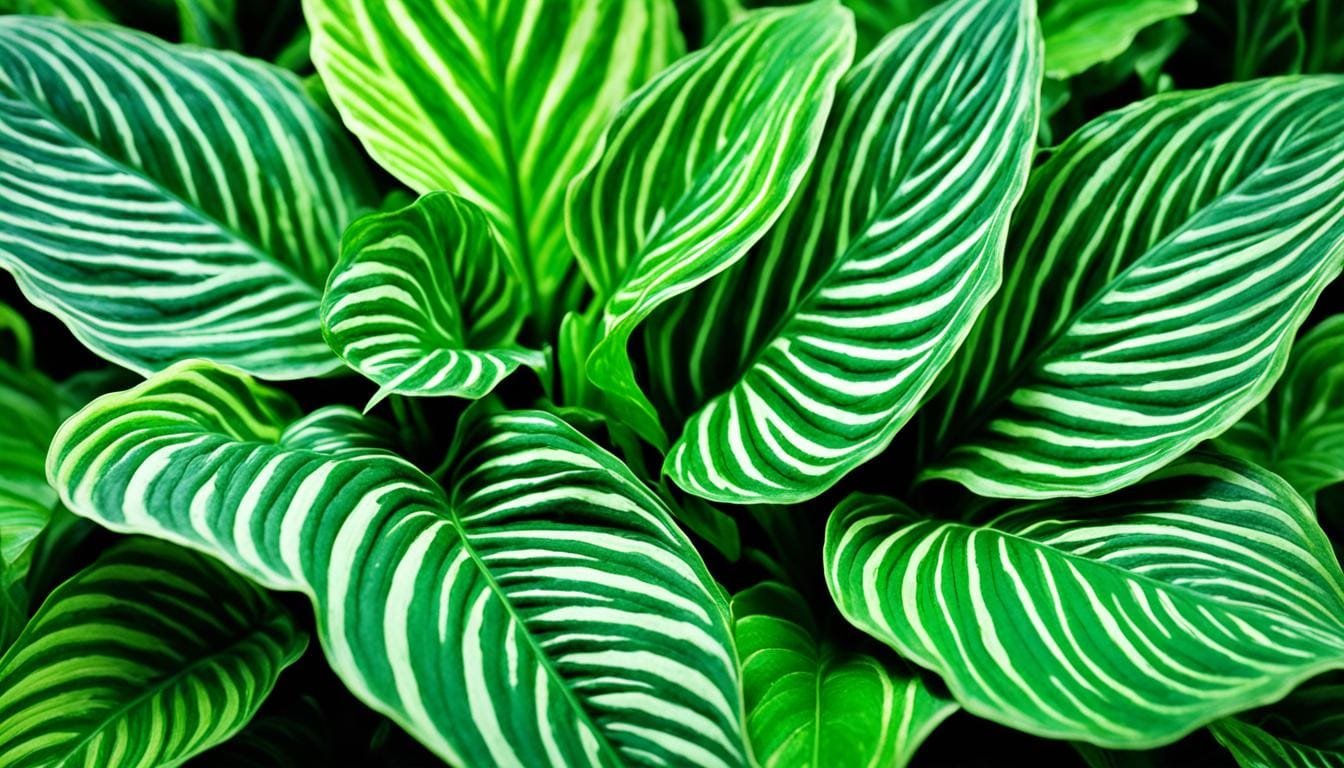Welcome to the complete guide to the Velvet Calathea! This plant is not just beautiful. It also cleans the air. This surprising fact is just one of many things you’ll learn about this amazing plant here. Whether you are new to plants or have been loving them for years, this guide has everything you need. You’ll learn how to keep a Velvet Calathea happy in your home.
Key Takeaways
- Learn how to grow and maintain a Velvet Calathea indoors
- Discover why Velvet Calathea is a popular choice for apartments
- Understand the unique care requirements and propagation methods
- Explore the stunning appearance and growth habits of the Velvet Calathea
- Find out how to prevent and treat common pests and diseases
Why Do We Love the Velvet Calathea For Apartments?
The Velvet Calathea is a great houseplant for your apartment. It’s beautiful and adds calm to any room.
Is the Velvet Calathea Air-Purifying?
Yes, the Velvet Calathea cleans the air. It removes toxins, making your home’s air better. It has big leaves that work like air filters. They take in bad air and give out fresh oxygen.
Is the Velvet Calathea Pet Friendly?
This plant is safe for pets. Cats and dogs won’t get sick from it. But keep pets from eating the leaves. Eating too much can upset their stomachs.
How Big Does the Velvet Calathea Get?
The Velvet Calathea’s size changes with light, warmth, and care. Usually, it grows to be 2 to 3 feet tall. It’s great for small places and doesn’t need much room.
The Velvet Calathea is loved for its look, clean air, and being safe for pets. It makes your apartment look great. It’s perfect for adding some green without needing a lot of space.
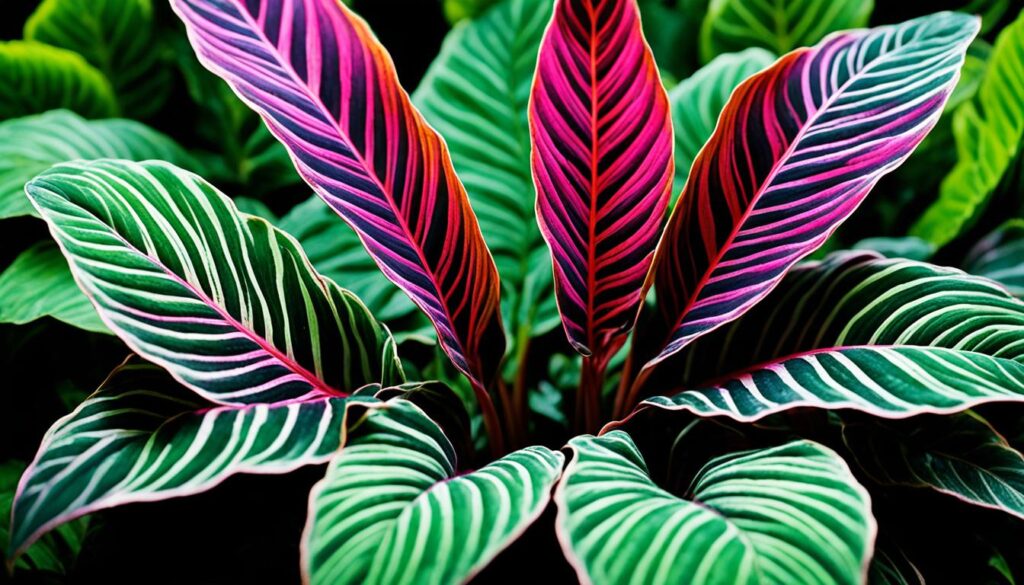
How to Grow a Velvet Calathea – Learn to Grow this Indoor Beauty
Velvet Calatheas need special care. I’ll show you how to grow a beautiful Velvet Calathea indoors.
Choosing the Right Pot and Soil
Select a pot with drainage holes. It prevents root rot by keeping roots dry. The pot needs to be big enough for the plant’s growth.
Use a potting mix that drains well but keeps moisture. A mix of peat, perlite, and sand is best for these plants.
Providing Adequate Light
These plants love bright, indirect light. Put them near windows that face east or west. This gives them the right amount of light. Never put them in direct sunlight because it burns the leaves.
If your place is dark, use grow lights. Full-spectrum LED lights work well.
Watering and Humidity
Water when the top inch of soil is dry. Don’t overwater to avoid rot. Make sure pots drain well.
Velvet Calatheas like it humid. Use a humidifier or a pebble tray with water. Sometimes mist the leaves to keep humidity right.
Nutrition and Fertilization
Feed them in spring and summer with a diluted fertilizer. Do this every 2-4 weeks but don’t overdo it.
Flush the soil now and then. This removes salt from the fertilizer. Velvet Calatheas don’t like salt buildup.
Pruning and Maintenance
Prune to keep the plant looking good. Take off any yellow or brown leaves. Cut back long stems for a fuller plant.
Clean dust off the leaves. This helps the plant breathe and stay healthy. Use a damp cloth or shower them.
Propagation
You can make more plants by division or stem cuttings.
For division, split the plant, making sure each part has roots. Then, plant them separately.
For cuttings, use a healthy stem. Dip it in rooting hormone and plant in moist soil. Cover with a plastic bag and keep it warm and light. After weeks, it will root and can be potted separately.
Monitoring for Pests and Diseases
Watch for spider mites, aphids, and mealybugs. Deal with them quickly if you find them.
Look for leaf spot and root rot signs. If leaves turn yellow or wilt, check your water and humidity. You might need to use a treatment.
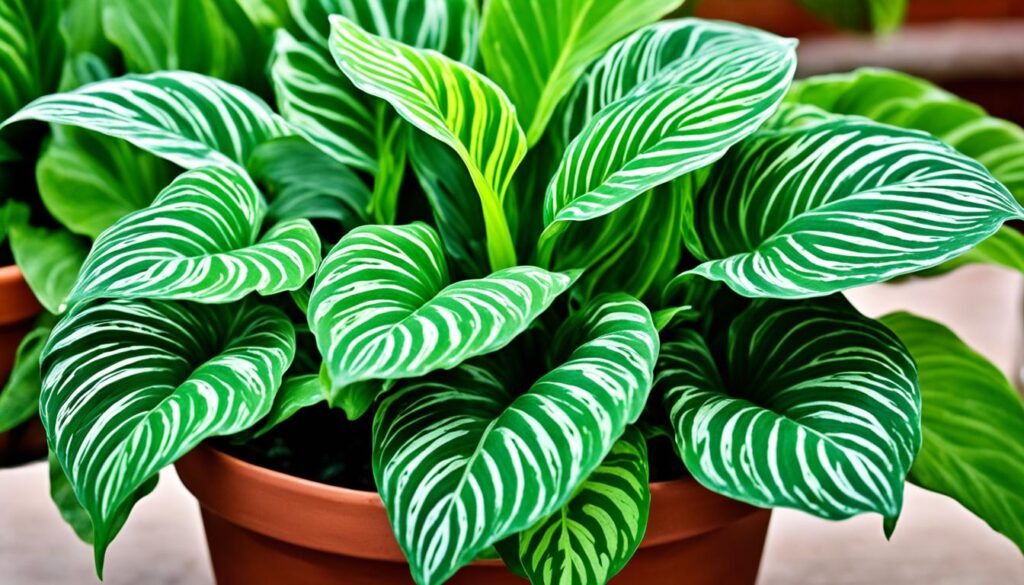
Appearance of Velvet Calathea
The Velvet Calathea is a stunning plant. It has velvety leaves, vibrant red stems, and deep blue-green foliage. The dark purple underside is eye-catching. The Velvet Calathea thrives in indirect light and prefers a humid environment, making it a perfect addition to a cozy indoor space. To ensure its health, it’s essential to keep the soil moist but not soggy, as overwatering can lead to root rot. For those looking to care for other tropical plants, searching for ‘fittonia verschaffeltii care tips‘ can provide valuable insights into maintaining lush greenery.
This plant feels soft and looks luxurious. Sunlight shining through its leaves creates beautiful light and shadows.
The Velvet Calathea grows in an elegant way. Its leaves stand upright, making the plant look full.
Its leaves are the star, with amazing colors and patterns. You’ll see greens, blues, and purples mixed together. The dark purple below is very pretty.
As it grows, the Velvet Calathea gets bigger leaves. It can get as tall as 2 to 3 feet. This makes it perfect for indoor areas.
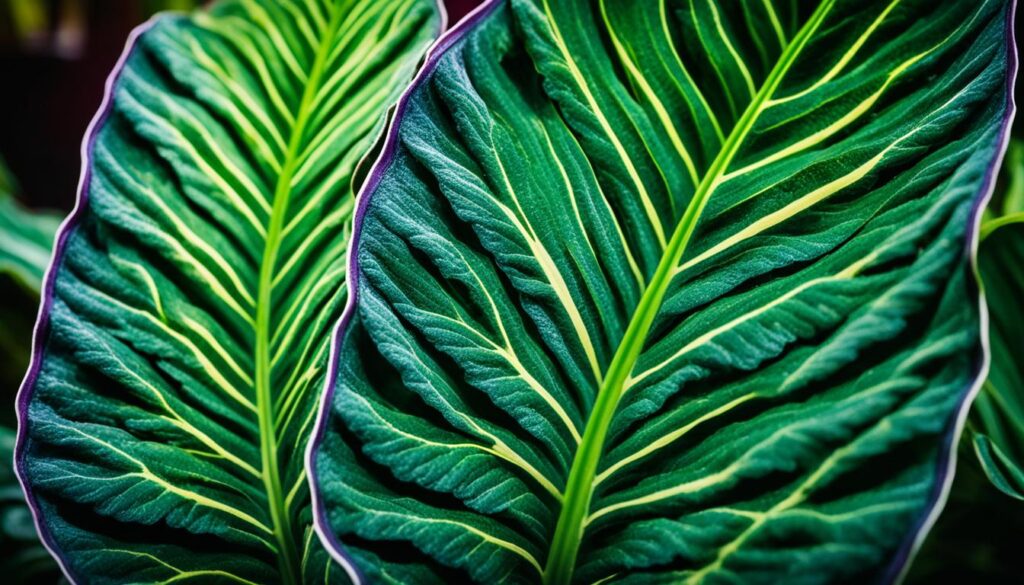
This plant is truly beautiful with its velvety leaves and bright colors. It makes any room look better.
Light Requirements for Velvet Calathea
Velvet Calathea needs the right light to grow happy and healthy. It must get the light it needs to do well in your home.
This plant loves light that is soft and spread out. It’s like the light under the trees where it comes from. Too much direct sun is bad for it. It can hurt its leaves.
Think about where to put your Velvet Calathea. It should be somewhere with bright, but not direct light. A spot near a window facing north or east is good. The sunlight there is softer.

If your place is a bit dark, don’t worry. You can use special lights to help your plant. Grow lights work well for plants indoors. They give the light your Velvet Calathea needs.
Getting the light right for your Velvet Calathea is very important. Too much light can make the leaves turn brown or fade. Not enough light makes the plant grow tall and thin. The leaves won’t look as nice.
Watch how your plant acts to the light it gets. Move it if needed to make sure it gets just the right light. This helps it grow best.
Watering Requirements of the Velvet Calathea
Watering right is key for the Velvet Calathea’s health. This part will show how to water this beautiful plant. We’ll make sure it gets just the right amount of water for good growth.
For the Velvet Calathea, balance in watering is essential. Keep the soil just moist but not too wet. Too much water can cause root rot.
Check the soil before watering by putting your finger in it. If it feels dry an inch down, it’s time to water. If it’s damp, wait a bit more.
Water with filtered, room-temperature water. Slowly pour until water comes out the bottom. Then, throw away any extra water to avoid too much moisture.
Let’s see how to tell if you’re watering too much or not enough.
Signs of Overwatering
Too much water can be bad for your plant. Look for these signs:
- Yellowing or browning leaves
- Leaves wilting or drooping
- Bad smell from the soil
- Mold or fungus on the soil
See these signs? Water less and let the soil dry before watering again.
Signs of Underwatering
Not enough water can hurt the plant too. Signs include:
- Wilting or drooping leaves
- Dry or brittle leaves
- Leaf edges turn brown or crispy
- Slow growth
Seeing these? Water more often, keeping the soil slightly moist.
By watching your plant and watering right, you keep it healthy. The right water balance is crucial for this lovely indoor plant.
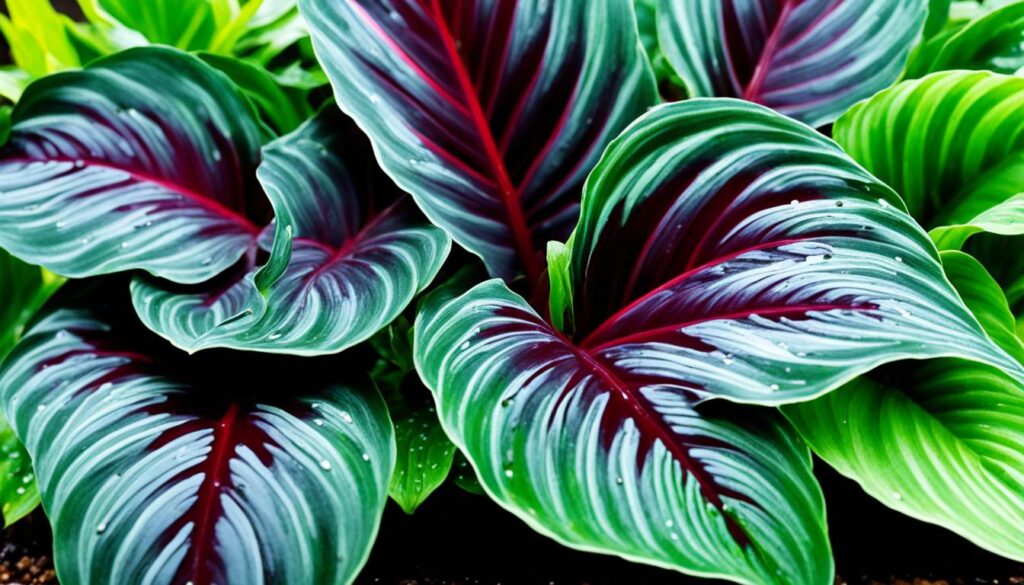
Fertilizing a Velvet Calathea
Fertilizer is key to making your Velvet Calathea beautiful. It gives your plant the food it needs. This section talks about why it’s good to use fertilizer. I’ll also share tips on what kind to use and how often.
Recommended Fertilizer for a Velvet Calathea
When picking a fertilizer, think about what your plant needs. Use a water-soluble one with equal parts nitrogen, phosphorus, and potassium. Like a 10-10-10 or 20-20-20 mix. This mix helps your plant grow well.
Also, pick a fertilizer made for indoor or tropical plants. These have extra good stuff like iron and magnesium. It’s what Velvet Calatheas love.
Be sure to use the right amount by following the instructions. Too much can hurt your plant. If you’re new to this, use a little less fertilizer than suggested.
Always water your plant before fertilizing. This protects the roots and spreads the fertilizer evenly.
Here’s a good fertilizer for Velvet Calatheas:
| Fertilizer Name | NPK Ratio | Benefits |
|---|---|---|
| Indoor Plant Fertilizer | 10-10-10 | Provides balanced nutrition for healthy growth |
| Tropical Foliage Plant Food | 20-20-20 | Specifically formulated for tropical plants |
| Organic Plant Fertilizer | Varies | Natural and environmentally-friendly option |
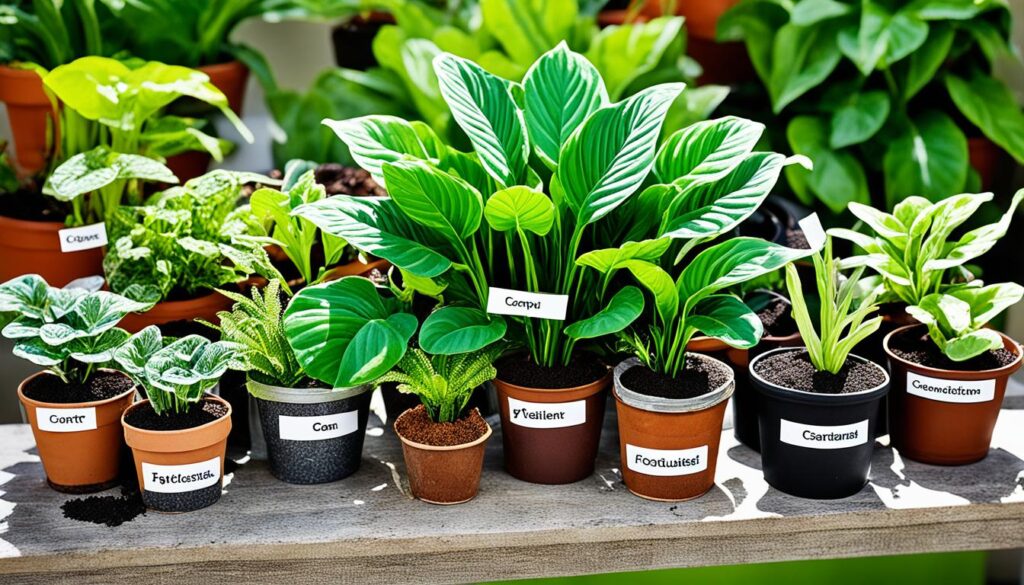
Choosing a fertilizer depends on what you can find and like. Just make sure it’s balanced for indoor or tropical plants. Your Velvet Calathea will be happier if it’s fertilized right.
Now you know how to feed your Velvet Calathea. Let’s look at the best pots for it next.
Potting a Velvet Calathea
Potting helps your Velvet Calathea grow. I’ll show how to pot, choose the right pot, and pick the best soil. I’ll also tell when to repot.
Choosing the Right Pot Size
For a Velvet Calathea, pick a pot a bit bigger than its roots. This gives it space to grow.
The plant likes moist soil but hates too much water. Use a pot with holes. Terra cotta or ceramic pots are great for air and moisture.
Using the Right Potting Mix for a Velvet Calathea
The soil mix is very important. It should keep the soil moist but not wet. This helps the plant stay healthy.
A good mix for a Velvet Calathea includes:
- Peat moss: Keeps soil moist and soft.
- Perlite or vermiculite: Makes soil drain better.
- Coconut coir: Helps hold moisture.
- Organic compost: Feeds the plant.
Combine these for moisture but also good drainage. Change the soil mix every one to two years to keep it fresh.
Repotting When Necessary
Sometimes your plant gets too big for its pot. Or the soil doesn’t drain well anymore. Look for roots coming out of holes. That means it’s time to repot.
Take the plant out gently. Loosen its roots. Then, put it in a new pot with fresh soil. Make sure it sits like before. Water it a little to settle the soil.
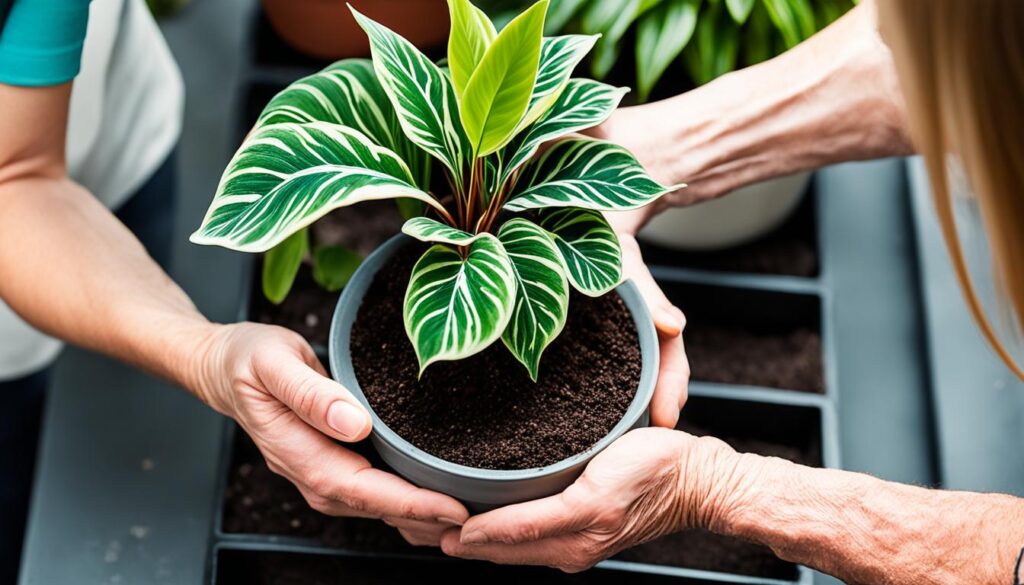
Right potting makes a happy Velvet Calathea. Pick the correct pot, use the best soil mix, and repot when needed. Then your plant will grow well.
Propagating a Velvet Calathea
Making new Velvet Calathea plants is fun. You can grow your garden or give plants to others. You can use stem cuttings or split the plant. Both ways work well if you do them right.
Stem Cuttings Or Seeds?
One way to make new Velvet Calathea plants is with stem cuttings. You take a stem from a grown plant. Then it grows roots and becomes a new plant. Stem cuttings often work better than seeds. You get a plant just like the one you took the stem from.
To make a new plant with a stem cutting, do this:
- Choose a healthy stem with two leaves.
- Cut the stem with clean scissors below a leaf node. Make it 4-6 inches long.
- Take off the bottom leaves, leaving 1-2 at the top.
- Put the stem in water. Make sure a leaf node is underwater.
- Keep it in a light, warm spot. Not in direct sunlight.
- Change the water often so it stays clean.
- When roots grow 1-2 inches, put the stem in a pot with soil.
- Keep the pot warm and mist the leaves to help it grow.
- Take care of it like you do the parent plant.
Another way to make new plants is by dividing the parent. If your Velvet Calathea is too big, you can split it into smaller plants. This makes the original plant healthier and gives you more plants.
To split a Velvet Calathea, do this:
- Take the plant out of its pot carefully.
- Split it into parts with roots and leaves on each.
- Put each part in its own pot with good soil.
- Water them well but let extra water drain.
- Put the pots where it’s warm and bright but not in direct sun.
- Look after the new plants like the parent plant.
You can make new Velvet Calathea plants with cuttings or by dividing. Pick the way that works best for you. With care and patience, your new plants will grow well.
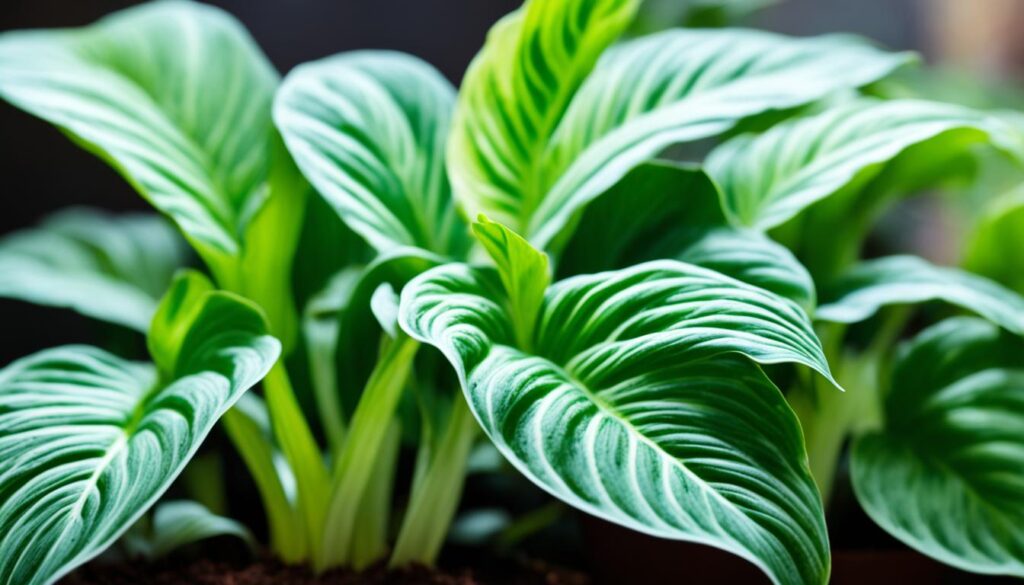
Growth and Development of the Velvet Calathea
It’s really important to know how the Velvet Calathea grows. This helps us take care of it the right way. We will look at what affects its growth like light, water, and food.
The Velvet Calathea grows at a moderate speed. How fast it grows depends on where it is. With the right care, it can grow up to 2 feet tall. This makes it a beautiful plant for inside your home.
Lighting: Good light is key for the Velvet Calathea. It does best in bright places but not in direct sun. Direct sun can harm its leaves. If it’s too dark, the plant won’t grow well and its leaves will be weak.
Watering: This plant needs the right amount of water. The soil should be a little wet. Water it when the top inch of soil is dry. Too much water is bad, but too little water is also bad for it.
Nutrition: The right food helps the Velvet Calathea grow strong. Use plant food that is balanced. It’s good to use a diluted mix so you don’t harm the plant.
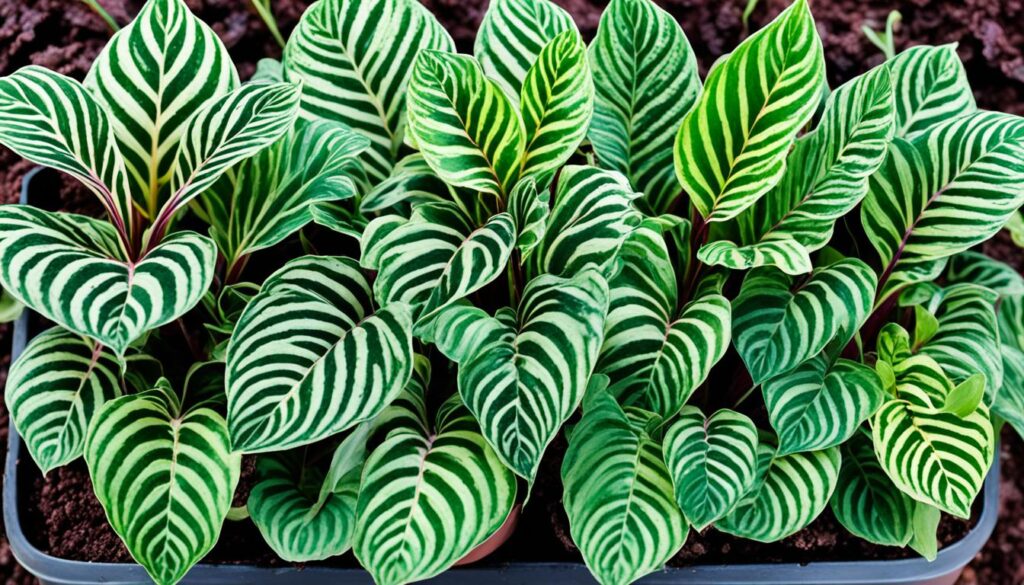
Many things affect how the Velvet Calathea grows. We must give it the right light, water, and food. With good care, you’ll see its lovely green leaves.
Dealing with Pests and Diseases in the Velvet Calathea
Velvet Calathea plants can get sick or attract bugs. It’s important to check your plant often. If you see bugs or signs of disease, act fast. We will talk about what harms Velvet Calathea and how to fix it.
Pests
Some common pests that bother Velvet Calathea include:
- Spider mites: These tiny bugs eat plant leaves, making them turn yellow and spotted.
- Mealybugs: Mealybugs look white and fluffy. They suck the sap and cause the plant to wilt and look yellow.
Here’s how to stop pests:
- Check your plant a lot to find pests early.
- Wipe off pests with a wet cloth or use water to wash them away.
- Use natural predators like ladybugs to reduce pests.
- If pests are still there, you may need safe bug sprays as per instructions.
Diseases
Common diseases that can affect the Velvet Calathea include:
- Leaf spot disease: Leaf spot makes dark spots on leaves and can make the plant sick. It happens with too much water, bad air flow, or fungus.
To fight diseases:
- Cut off sick leaves to stop the disease from spreading.
- Give your plant enough space to breathe and avoid putting too many plants close.
- Water the plant at the bottom to keep leaves dry and avoid fungus.
- Use special fungus killers if you need to, and follow the guide.
Common Velvet Calathea Pests
I will talk about pests that harm the Velvet Calathea. I’ll give you info on how to find, stop, and get rid of these pests. The Velvet Calathea looks pretty but can get bugs. If you watch carefully, your plant can stay healthy and look good.
Spider mites are a big problem for the Velvet Calathea. They eat the plant’s juices, making the leaves change color and fall off. To find spider mites, look for webs under the leaves and tiny moving dots.
Aphids are another bug that can hurt your plant. They suck the plant’s sap, making leaves twist and look bad. You can find them in groups on leaves and stems. Without treatment, they quickly get worse.
Mealybugs also love the Velvet Calathea. You can find these white bugs under the leaves and where leaves meet stems. They eat the plant’s food, making it not grow well and the leaves turn yellow.
Pests can make your Velvet Calathea weak and sick. It’s important to act fast if you see bugs on your plant.
It’s best to stop pests before they start. Here are ways to keep bugs away from your Velvet Calathea:
- Look at your plants for bugs. Pay more attention to under the leaves and where leaves meet stems.
- Keep sick plants away from healthy ones to stop bugs from moving.
- Keep the area clean by picking up fallen leaves and trash.
- Don’t water too much. Too much water makes a home for bugs.
- Watch the room’s wetness. Some bugs like it very wet.
If your plant still gets bugs, you can try these ways to get rid of them:
- Organic control methods: Use ladybugs or special soaps and oils to fight the bugs.
- Chemical control methods: Sometimes you need bug spray. But use it carefully to keep your plant and earth safe.
Stopping bugs is best, but acting fast can save your Velvet Calathea. Watch your plant closely. Use good bug control to keep it beautiful and healthy for a long time.
Natural Predators
Dealing with pests in Velvet Calathea involves using natural predators. These good bugs help control pests without chemicals. By adding them to your indoor garden, you make a healthy space. This keeps pests away.
Isolate Infected Plants
Is your Velvet Calathea plant sick with pests? Then, keep it away from your other plants. This stops pests from spreading. Put the sick plant by itself and watch it. Doing this helps save your other plants.
Chemical Treatment
Sometimes you need chemicals to fight off pest invasions. Yet, always think of this as your last option. Be careful to pick the right pesticide for indoor plants and Velvet Calatheas. Use it just as the instructions say. This keeps you and your plants safe.
Disease Prevention For Velvet Calatheas
Keeping your Velvet Calatheas healthy is all about prevention. Use simple steps to avoid diseases and keep your plants healthy.
It’s very important to keep things clean. Make sure to clean your gardening tools and pots regularly. This stops disease from spreading.
Watering right is key. Too much water causes root rot. Too little stress the plant. So, water your Velvet Calatheas just right to avoid soggy soil.
Checking your plants often helps catch diseases early. Look for spots, changes in color, or wilting. If you see problems, fix them quickly to stop diseases.
Tips for Maintaining Velvet Calatheas
Maintaining your Velvet Calatheas helps them stay healthy and beautiful. Follow some easy tips and tricks for the best results. We’ll talk about cleaning leaves, time outside, and water needs.
Wiping Leaves
Gently wiping your Velvet Calatheas’ leaves is key. Their soft leaves can get dusty, blocking light needed for growth. Use a damp cloth to clean them. This keeps pests and diseases away, too.
Outdoor Exposure
Sometimes, take your Velvet Calatheas outside. This gives them fresh air and a little change in light. But keep them safe from too much sun, wind, and cold. Slowly get them used to being outside, then bring them back in when it gets cold.
Adjusting Watering Schedule
Changing when you water is crucial. Water more when it’s warm and they are growing. Water less when it’s cold or they are resting. Always check the soil to see if it’s dry before watering.
Use these tips for happy, healthy Velvet Calatheas. They’ll make your space bright and beautiful.
Tips for Successful Overwintering of Velvet Calathea
Taking care of Velvet Calathea in winter requires special steps. When it gets cold, this plant grows slower and can get hurt easily. To keep your Velvet Calathea safe and healthy until spring, here are some tips:
- Water less often: In winter, water the plant less because it grows slower. Wait for the top inch of soil to dry before watering. But, make sure it doesn’t get too dry.
- Bright but not direct light: Put your Velvet Calathea where it gets plenty of light but no direct sun. Direct sunlight in winter can harm its leaves.
- Keep it humid: Velvet Calatheas love moisture in the air. Use a humidifier or a water tray to keep the air moist around it.
- Stay away from drafts: Don’t place your plant near cold drafts from windows or doors. Cold air can harm its leaves.
- Avoid hot spots: Keep it away from heaters or radiators to avoid sudden heat changes. It likes stable temperatures best.
Follow these steps to keep your Velvet Calathea happy during winter. With proper care, it will show off its beautiful leaves and colors in spring.
Growing Velvet Calathea from Seed
Planting Velvet Calathea seeds is both fun and rewarding. To start growing this amazing indoor plant, just follow these steps:
- First, pick high-quality seeds. You can get them from a trusted store or use seeds from your own Velvet Calathea plants.
- Then, get a potting mix that drains well and is good for seeds. Make sure it’s moist but not too wet to stop rot and fungus.
- Put the seeds on top of the soil and press them down lightly. They need light to grow, so don’t bury them too deep.
- Next, cover the pot with clear plastic to make a mini greenhouse. This keeps the air moist, which helps the seeds start growing.
- Keep the pot in a warm spot with light but no direct sun. Velvet Calathea seeds do best in temperatures between 70-80°F (21-27°C).
- Check the soil often and spray it if it starts to dry. But don’t water it too much. Too much water can cause disease in the plants.
- It might take 2-4 weeks for the seeds to start growing. When you see seedlings, take the plastic off and move the pot to a bright spot.
- Make sure the young plants have enough water but are not in direct sunlight. Direct sun can hurt their leaves.
- After about 4-6 weeks, you can move the seedlings to their own pots. Be gentle with their roots. Use a potting mix that drains well.
- Keep taking care of the Velvet Calathea plants as they get bigger. Follow the care tips for grown-up plants, like how to water and where to place them.
With some care and patience, your seedlings will become beautiful Velvet Calathea plants. Have fun watching them grow!
Varieties of Velvet Calathea
The Velvet Calathea is part of a big plant family. It has lots of stunning types to pick from. Let me introduce you to two popular types: Calathea warscewiczii and Calathea rufibarba.
Calathea warscewiczii: It has big, long leaves that are deep green with beautiful silver lines. The leaves feel like velvet, making it very pretty. It likes bright light but not direct sun and loves moist air. It’s also small, perfect for tiny places.
Calathea rufibarba: Known as “Furry Feather,” it has long, slender leaves. They’re soft and green with a hint of burgundy below. It needs light but no direct sun and enjoys damp air. It can get tall, adding beauty to any room.
When picking a Velvet Calathea type, think about what you like. Also, consider how much light you have and how it will look in your room. You might like the silver lines of Calathea warscewiczii. Or maybe the soft leaves of Calathea rufibarba. Either way, they will make your home look great.

